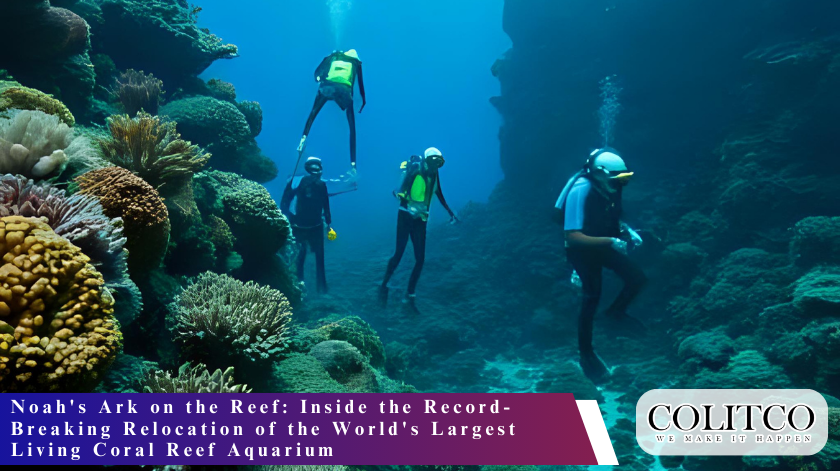Staff at Townsville’s Great Barrier Reef Aquarium have completed one of the most complex marine life relocation projects ever undertaken. The extraordinary behind-the-scenes mission to rehome hundreds of marine creatures has been hailed as one of the biggest living coral reef aquarium relocations in the world.
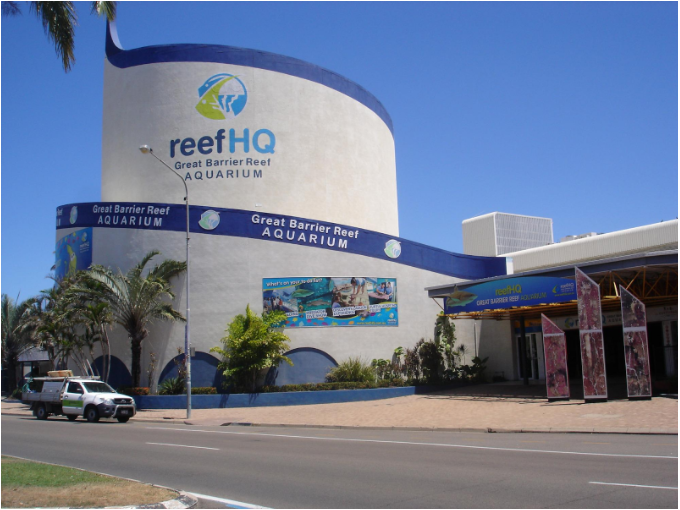
The Great Barrier Reef Aquarium in Townsville
Unprecedented Scale of Marine Life Relocation
In February 2021, the Great Barrier Reef Aquarium shut down to undergo a one-generation transformation. The rehabilitation of the facility is a redevelopment project worth $180 million and includes a huge logistical operation, which means a reopening in 2029.
Staff launched the modern-day Noah’s Ark uplift, safely relocating all animals in the facility’s care from sharks to sea snakes and crocodiles to the tiniest coral polyps. The Aquarium’s renowned Coral Reef Exhibit underwent a careful uplift to purpose-built facilities at the Australian Institute of Marine Science (AIMS).
Over three months, more than 5.5 tonnes of reef rock, sand, delicate corals and fish were moved to AIMS’ state-of-the-art National Sea Simulator at Cape Cleveland, 50 kilometres south of Townsville. The creatures remain under the daily care of Aquarium staff until the reopening.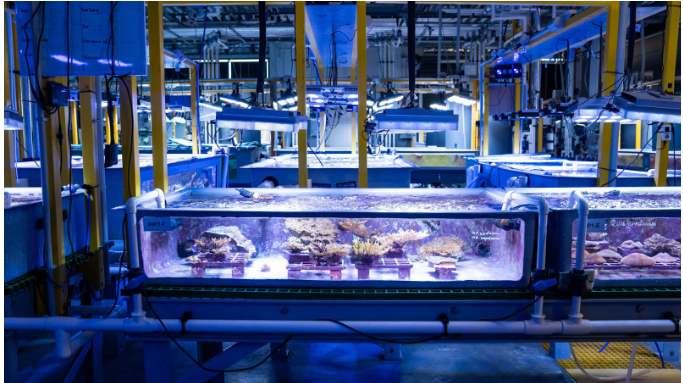
Australian Institute of Marine Science
Complex Animal Care and Transportation Methods
The relocation required months of conditioning fish to voluntarily enter a sea cage. Staff implemented gradual acclimatisation processes to new environments with round-the-clock monitoring to reduce stress.
Each move was tailored to the specific needs of individual species. The project involved specialist aquarists, marine biologists, divers, and animal welfare experts working side by side.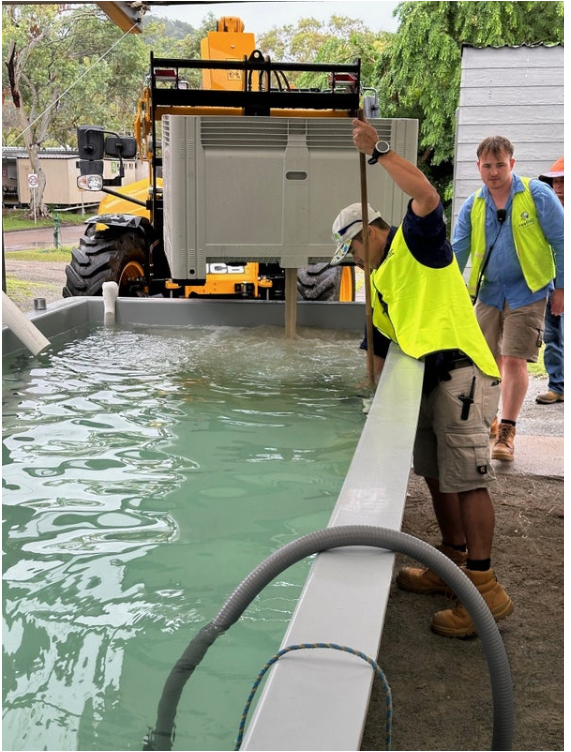
Shark Relocation Challenges
Relocating sharks in the Predator Tank was one of the most challenging tasks. One of the Tawny Nurse Sharks, called Snuggles, had to be transported to a new home in Sea World on the Gold Coast by a specialist.
Specialist sea cages, cranes, three separate trips in temperature-controlled trucks, and expert veterinary oversight helped the sea creatures arrive safely after an epic 1,400-kilometre road trip.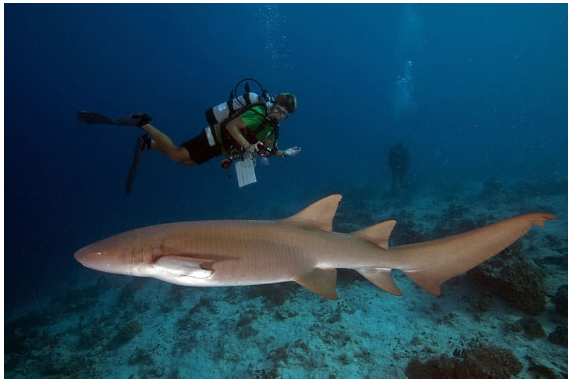
Marine Species Accommodation
Other star Aquarium residents such as Sadie, a Longnose Butterflyfish, and her tank mates including Yellow Surgeonfish, Clown Coris, Humpnose Unicornfish, and Lined Rabbitfish have settled into their temporary reef home at AIMS.
Staff rehomed snakes and crocodiles to partner sanctuaries like Billabong Sanctuary. The intricate care of pelagic fish and reef corals required specialised treatment protocols.
National Sea Simulator Facility Specifications
The Australian Institute of Marine Science’s National Sea Simulator offers researchers with advanced coral reef research capabilities. The facility allows manipulation of key environmental factors including light, temperature, acidity, carbon dioxide, salinity, sediments and contaminants.
SeaSim opened in 2013 with $37 million from the Education Investment Fund and AIMS. In 2021, the Australian Government announced a $36.3 million SeaSim expansion, increasing the capacity of large tank systems fivefold.
The facility has facilities for long-term holding and propagation of corals as model organisms for research. This allows multi-generational studies, which are critical in understanding how marine organisms adapt to changing environments.
Historical Context and Significance
In 1987, the 2.5 million litre Aquarium (then called Reef HQ) was opened and became the largest living coral reef display in the world. The facility exposed the marvels of the Great Barrier Reef to everyone of every age and capability.
Since its establishment, the Great Barrier Reef Aquarium has received more than 4.5 million visitors and virtual programmes have been accessed and delivered by the aquarium to 105,000 individuals in 34 countries. The plant has emphasised the dedication of Australia to protect the reefs.
Project Leadership
The operation was described by Fred Nucifora, the General Manager of Major Projects, at the Great Barrier Reef Marine Park Authority as unprecedented. This was a greatly unprecedented operation, as it demonstrates the sort of dedication, accuracy and cooperation that was required to safeguard one of the most spectacular living collections in the world, he said.
Nucifora emphasised the logistical complexity involved. “It’s been a huge logistical effort, easily one of the biggest and most complex of its kind,” he said.
“This complex relocation was about more than moving animals – it was about preserving the heart of the Aquarium as we progress to reopen a world-class facility in 2029 to continue to tell the story of the Reef and educate visitors for years to come,” he added.
Technical Specifications and Infrastructure
There are 2.5 million litres of water, 700 tonnes of limestone rock and sand in the coral reef tank. The personnel cleared the premises to look at the structural integrity beneath the slab of concrete.
The facility requires specialised technical requirements for each animal display. The team creates specific conditions, including tidal systems within tanks. Every living exhibition is bespoke in nature, depending on the animals being housed.
Coral Propagation and Scientific Research
Marine scientists at AIMS are propagating new corals in their facilities. The technology will return to the Great Barrier Reef Aquarium as part of the new design. The facility will have what is akin to a coral farm as part of the aquarium’s design.
AIMS has increased the number of corals bred in aquaria, with more than 50 Great Barrier Reef species spawning in the SeaSim over the past five years. AIMS has developed an automated system, the Autospawner, which facilitates fertilisation of large quantities of coral eggs with minimal labour.
Future Development and Reopening Plans
Animals are safe in temporary residences, and preparations are being made for another generation of immersive exhibits before the grand reopening of the Aquarium in 2029. The transformed Aquarium will bridge innovative marine science, conservation narration, and experiences.
The facility will remind people that it is a National Education Centre of the Great Barrier Reef in Australia. A new state-of-the-art sustainable facility will showcase the magic of the Great Barrier Reef.
The additional funding represents a commitment between the Australian Government, Queensland Government and Townsville City Council to create jobs, increase economic growth and revitalise the city.
Long-Term Animal Care Protocols
The Aquarium opened in 1987 with corals that remained in care for the entire operational period. These corals are still in care at bespoke facilities at AIMS. The corals will return to the aquarium to be in ongoing care for future years.
Staff maintain a proud history of animal husbandry and capabilities, particularly in live coral reefs. The team has had corals in care for the entire existence and will continue to have those corals in care for the rest of the facility’s existence.
Economic and Community Impact
The $180 million redevelopment project includes $80 million previously allocated funding. Complexity associated with the bespoke build, together with dramatic increases in construction costs, had caused delays to the project.
The new injection of funding ensures the Great Barrier Reef Aquarium is delivered in full. The facility has funding security, and is on track to be delivered in 2029.
Also Read: Antarctic Blast Delivers Final Winter Snow Across Five Australian States
Marine Life Transportation Technology
The relocation utilised temperature-controlled trucks for long-distance animal transport. Specialist veterinary oversight was required for all marine creature movements. The team employed cranes and specialist sea cages for larger marine species.
There are certain guidelines that are related to fish transportation in order to preserve the quality of water in transit. The significant water quality impacts of fish during transport include low dissolved oxygen content, carbon dioxide build-up, low PH and elevated concentrations of ammonia.
Conservation and Research Implications
The project demonstrates Australia’s commitment to reef protection and marine conservation. The facility continues to play a vital role in Reef education, science, and storytelling.
The Great Barrier Reef Marine Park Authority looks forward to continuing engagement and design work with partner organisations. The goal is to deliver a world-leading educational facility which has been an icon in the North Queensland community for more than 35 years.
Structural Assessment and Construction Planning
The team is conducting final discovery phases to inform full scope of works and final designs. This phase is critically important to ensure building a facility that will last for the next 40 years and multiple generations.
All steps are taken to fast-track the redevelopment project where possible while ensuring public funds are managed responsibly and effectively. The road to reopening is filled with transformation, innovation, and deep commitment to deliver a world-class Aquarium.
The original 38-year-old Aquarium building remains standing on Kelleher Place and has not been demolished. Adjacent structures on the former Wonderland site, including the IMAX Theatre, office spaces, and Cultural Centre, were cleared to improve visitor access.
Educational Legacy and Future Vision
The Great Barrier Reef Aquarium will continue serving as Australia’s National Education Centre for the Great Barrier Reef. The facility provides immersive experiences for people of all ages and abilities.
The revamped aquarium will offer top-tier reef education for Queenslanders and national and international visitors. The facility represents an enduring symbol of Townsville’s rich history and international reputation for Reef education.
Planning includes investigating incorporation of a Turtle Hospital into designs to ensure important conservation work continues. The facility aims to foster collaboration whether in classroom or community settings to protect one of the world’s most precious ecosystems.
FAQ: The Great Barrier Reef Aquarium
General Project Questions
Q: When will the Great Barrier Reef Aquarium reopen?
The aquarium is scheduled to reopen in 2029, though the authority is taking steps to fast-track the timeline where possible.
Q: Is there enough funding to complete the project?
Yes, the project has funding security with $180 million allocated (including $80 million previously allocated), with an additional $100 million announced in late 2024.
Q: Was the original aquarium building demolished?
No, the original 38-year-old aquarium building remains standing on Kelleher Place. Only adjacent structures on the former Wonderland site were demolished to improve visitor access.
Animal Welfare and Relocation
Q: Where are all the animals during the closure?
The coral reef exhibit animals are housed at the Australian Institute of Marine Science’s National Sea Simulator. Larger animals were relocated to partner facilities like Sea World Gold Coast and Billabong Sanctuary. All animals remain under the care of aquarium staff.
Q: How were the animals safely transported?
The relocation used specialist equipment including temperature-controlled trucks, sea cages, cranes, and veterinary oversight. Fish were conditioned for months to voluntarily enter transport containers, with round-the-clock monitoring to reduce stress.
Q: What happened to the sharks?
Sharks from the Predator Tank, including “Snuggles” the Tawny Nurse Shark, were relocated to Sea World Gold Coast using specialist transport methods over 1,400 kilometres.
Technical and Construction
Q: When will construction officially start?
Construction is expected to commence in 2026, pending approval from the Senate Committee on Public Works for the scope of works and spending plans.
Q: What will the new aquarium include?
The facility will feature cutting-edge marine science, conservation storytelling, interactive experiences, and potentially a turtle hospital. It will maintain its role as Australia’s National Education Centre for the Great Barrier Reef.
Q: How much coral and marine life was relocated?
Over 5.5 tonnes of reef rock, sand, delicate corals, and fish were moved to AIMS over three months.
Design and Planning
Q: When can we see the new designs?
Design approval is expected by the end of 2025, with concepts to be released once finalised. The facility must gain development approval from council and government oversight.
Q: Will the turtle hospital continue?
Yes, the authority is investigating incorporating a turtle hospital into the new designs to ensure this conservation work continues.
Project Scope and Impact
Q: How long did the relocation take?
The animal relocation was completed over several months, with the coral reef exhibit moved over three months specifically.
Q: What makes this relocation significant?
It’s been described as one of the biggest living coral reef aquarium relocations in the world, involving hundreds of marine creatures from the world’s largest living coral reef exhibit.
Q: Will the relocated animals return?
Yes, the animals will return to support the commissioning of new living exhibits and reduce the need for wild-stock collection when the aquarium reopens.
Visitor and Community Impact
Q: How many people visited the original aquarium?
Since opening in 1987, the aquarium welcomed over 4.5 million visitors and reached 105,000 people in 34 countries through virtual programmes.
Q: What role will the new aquarium play?
It will continue as Australia’s National Education Centre for the Great Barrier Reef, offering world-class living exhibitions and immersive experiences to educate about reef conservation.

